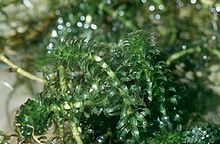Hydrilla: Difference between revisions
m Reverted edits by 206.219.168.142 to last version by The Thing That Should Not Be (GLOO) |
Jboltonnal (talk | contribs) No edit summary |
||
| Line 36: | Line 36: | ||
==References== |
==References== |
||
{{reflist}} |
{{reflist}} |
||
==External Links== |
|||
* [http://www.invasivespeciesinfo.gov/aquatics/hydrilla.shtml Species Profile- Hydrilla (''Hydrilla verticillata'')], National Invasive Species Information Center, [[United States National Agricultural Library]]. Lists general information and resources for Hydrilla. |
|||
[[Category:Hydrocharitaceae genera]] |
[[Category:Hydrocharitaceae genera]] |
||
Revision as of 15:05, 16 February 2011
| Hydrilla | |
|---|---|

| |
| Scientific classification | |
| Kingdom: | |
| (unranked): | |
| Order: | |
| Family: | |
| Genus: | Hydrilla |
| Species: | H. verticillata
|
| Binomial name | |
| Hydrilla verticillata | |
Hydrilla (Esthwaite Waterweed or Hydrilla) is an aquatic plant genus, usually treated as containing just one species, Hydrilla verticillata, though some botanists divide it into several species. Synonyms include H. asiatica, H. japonica, H. lithuanica, and H. ovalifolica. It is native to the cool and warm waters of the Old World in Asia, Europe, Africa and Australia, with a sparse, scattered distribution; in Europe, it is reported from Ireland, Great Britain, Germany, and the Baltic States, and in Australia from Northern Territory, Queensland, and New South Wales.[1][2][3]
It has off-white to yellowish rhizomes growing in sediments at the water bottom at up to 2 m depth. The stems grow up to 1–2 m long. The leaves are arranged in whorls of two to eight around the stem, each leaf 5–20 mm long and 0.7–2 mm broad, with serrations or small spines along the leaf margins; the leaf midrib is often reddish when fresh. It is monoecious (sometimes dioecious), with male and female flowers produced separately on a single plant; the flowers are small, with three sepals and three petals, the petals 3–5 mm long, transparent with red streaks. It reproduces primarily vegetatively by fragmentation and by rhizomes and turions (overwintering buds), and flowers are rarely seen.[2][4][5][6]
Hydrilla has a high resistance to salinity (>9-10ppt) compared to many other freshwater associated aquatic plants.
The name Esthwaite Waterweed derives from its occurrence in Esthwaite Water in northwestern England, the only English site where it is native, but now presumed extinct, having not been seen since 1941.[7] Hydrilla closely resembles some other related aquatic plants, including Egeria and Elodea.
Status as an invasive plant


Hydrilla is naturalised and invasive in the United States following release in the 1960s from aquariums into waterways in Florida. It is now established in the southeast from Connecticut to Texas, and also in California.[8] By the 1990s control and management were costing millions of dollars each year.
Hydrilla can be controlled by the application of aquatic herbicides and it is also eaten by grass carp, itself an invasive species in North America. Insects used as biological pest control for this plant include weevils of genus Bagous and the Asian hydrilla leaf-mining fly (Hydrellia pakistanae). Tubers pose a problem to control as they can lay dormant for a number of years. This has made it even more difficult to remove from waterways and estuaries.
As an invasive species in Florida, Hydrilla has become the most serious aquatic weed problem for Florida and most of the U.S. Because it was such a threat as an invasive species, restrictions were placed, only allowing a single type of chemical, fluridone, to be used as an herbicide. This was done to prevent the evolution of multiple mutants. The result is fluridone resistant Hyrdilla. “As hydrilla spread rapidly to lakes across the southern United States in the past, the expansion of resistant biotypes is likely to pose significant environmental challenges in the future.” [9]
Phytoremediation
This abundant source of biomas is a known bioremediation hyperaccumulator of Mercury, Cadmium, Chromium and Lead, and as such can be used in phytoremediation.[10]
References
- ^ Flora Europaea: Hydrilla
- ^ a b Flora of Taiwan: Hydrilla
- ^ Australian Plant Name Index: Hydrilla
- ^ Flora of NW Europe: Hydrilla verticillata
- ^ Blamey, M. & Grey-Wilson, C. (1989). Flora of Britain and Northern Europe. ISBN 0-340-40170-2
- ^ Huxley, A., ed. (1992). New RHS Dictionary of Gardening. Macmillan ISBN 0-333-47494-5.
- ^ Environmental Change Network: Esthwaite Water
- ^ Flora of North America: Hydrilla verticillata
- ^ Predicting the potential invasive distributions of four alien plant species in North America. Peterson, A. Townsend, Papes, Monica. Weed Science v. 51 no. 6 (November/December 2003). p. 863-82003.
- ^ McCutcheon & Schnoor 2003, Phytoremediation. New Jersey, John Wiley & Sons, page 898.
External Links
- Species Profile- Hydrilla (Hydrilla verticillata), National Invasive Species Information Center, United States National Agricultural Library. Lists general information and resources for Hydrilla.
- Hydrocharitaceae genera
- Aquatic plants
- Angiosperms of Western Australia
- Flora of the Northern Territory
- Flora of South Australia
- Flora of Queensland
- Flora of New South Wales
- Flora of Victoria (Australia)
- Monocots of Australia
- Monotypic plant genera
- Invasive plant species
- Invasive plant species in Florida
- Phytoremediation plants
